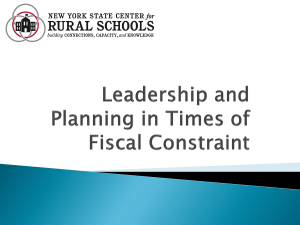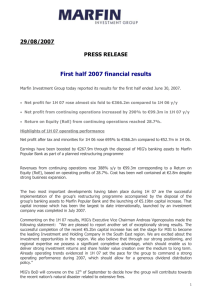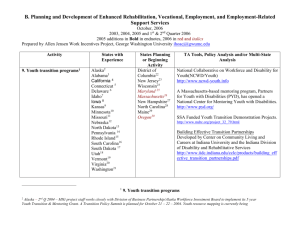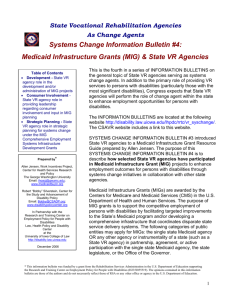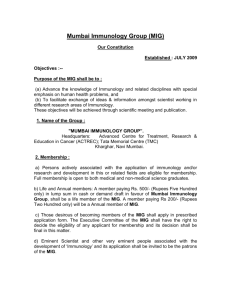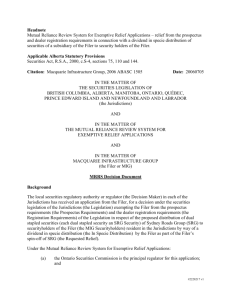Youth Transition Programs - Law, Health Policy & Disability Center
advertisement
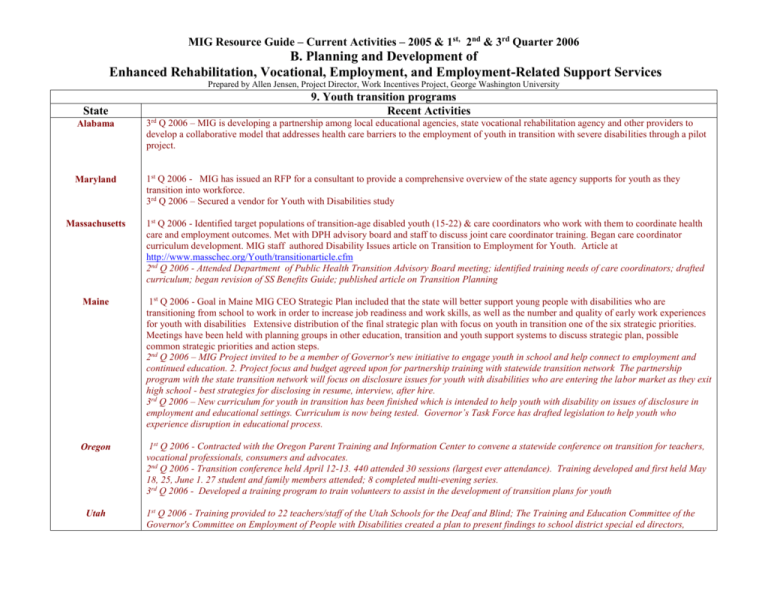
MIG Resource Guide – Current Activities – 2005 & 1st, 2nd & 3rd Quarter 2006 B. Planning and Development of Enhanced Rehabilitation, Vocational, Employment, and Employment-Related Support Services Prepared by Allen Jensen, Project Director, Work Incentives Project, George Washington University State 9. Youth transition programs Recent Activities Alabama 3rd Q 2006 – MIG is developing a partnership among local educational agencies, state vocational rehabilitation agency and other providers to develop a collaborative model that addresses health care barriers to the employment of youth in transition with severe disabilities through a pilot project. Maryland 1st Q 2006 - MIG has issued an RFP for a consultant to provide a comprehensive overview of the state agency supports for youth as they transition into workforce. 3rd Q 2006 – Secured a vendor for Youth with Disabilities study Massachusetts 1st Q 2006 - Identified target populations of transition-age disabled youth (15-22) & care coordinators who work with them to coordinate health care and employment outcomes. Met with DPH advisory board and staff to discuss joint care coordinator training. Began care coordinator curriculum development. MIG staff authored Disability Issues article on Transition to Employment for Youth. Article at http://www.masschec.org/Youth/transitionarticle.cfm 2nd Q 2006 - Attended Department of Public Health Transition Advisory Board meeting; identified training needs of care coordinators; drafted curriculum; began revision of SS Benefits Guide; published article on Transition Planning Maine 1st Q 2006 - Goal in Maine MIG CEO Strategic Plan included that the state will better support young people with disabilities who are transitioning from school to work in order to increase job readiness and work skills, as well as the number and quality of early work experiences for youth with disabilities Extensive distribution of the final strategic plan with focus on youth in transition one of the six strategic priorities. Meetings have been held with planning groups in other education, transition and youth support systems to discuss strategic plan, possible common strategic priorities and action steps. 2nd Q 2006 – MIG Project invited to be a member of Governor's new initiative to engage youth in school and help connect to employment and continued education. 2. Project focus and budget agreed upon for partnership training with statewide transition network The partnership program with the state transition network will focus on disclosure issues for youth with disabilities who are entering the labor market as they exit high school - best strategies for disclosing in resume, interview, after hire. 3rd Q 2006 – New curriculum for youth in transition has been finished which is intended to help youth with disability on issues of disclosure in employment and educational settings. Curriculum is now being tested. Governor’s Task Force has drafted legislation to help youth who experience disruption in educational process. Oregon 1st Q 2006 - Contracted with the Oregon Parent Training and Information Center to convene a statewide conference on transition for teachers, vocational professionals, consumers and advocates. 2nd Q 2006 - Transition conference held April 12-13. 440 attended 30 sessions (largest ever attendance). Training developed and first held May 18, 25, June 1. 27 student and family members attended; 8 completed multi-evening series. 3rd Q 2006 - Developed a training program to train volunteers to assist in the development of transition plans for youth Utah 1st Q 2006 - Training provided to 22 teachers/staff of the Utah Schools for the Deaf and Blind; The Training and Education Committee of the Governor's Committee on Employment of People with Disabilities created a plan to present findings to school district special ed directors, MIG Resource Guide – Current Activities – 2005 & 1st, 2nd & 3rd Quarter 2006 B. Planning and Development of Enhanced Rehabilitation, Vocational, Employment, and Employment-Related Support Services Prepared by Allen Jensen, Project Director, Work Incentives Project, George Washington University Disability Resource Centers, etc. Wisconsin 1st Q 2006 - Goal in MIG –CEO Strategic Plan is to increase the number of students with disabilities who have information about employment options and supports through Pathways programs. Strategy is to research and design effective means of providing students with disabilities the information and supports needed to make decisions about their futures after high school and to prepare for the transition to employment or postsecondary education. Topic areas include employment and educational options, the Individual Education Program (IEP) process and rights, person-centered planning, self determination, self advocacy and benefits counseling. Current status - Contract initiated, planning and training meetingss held, curriculum finalized, providers contracted, began designing research. Alaska MIG project staff works closely with Division of Business Partnership/Alaska Workforce Investment Board to implement its 5 year Youth Transition & Mentoring Grant. A Transition summit was held. MIG Project staff works with the youth grantees in the Youth Transition Project. 12 of the 50 enrollees were employed in 4th Quarter of 2005. Alaska 1st Q 2006 - The 4 youth intermediary grantees funded by the Youth In Transition (YIT)served 135 youth this quarter; 26 are employed. Staff worked with the Alaska Workforce Investment Board’s Youth Council on strategies for ensuring all youth, including youth with disabilities, are prepared for Alaska’s jobs. YIT funding from the Office of Disability Employment Policy ends September 30, two years early. Project staff facilitated several meetings to identify sustainability strategies upon termination of grant funding. 1st Q 2006 - Project staff worked with the Developmental Disability Waitlist Committee; as a result, priority consideration for services will be given to transition-age youth 2nd Q 2006 - The 4 youth intermediary grantees served 150 youth this quarter; 60 are employed. A variety of resources (i.e. in-kind support, legislative increment, local government, related grants) have been secured to continue intermediary services in all 4 locations. Problems/Issues YIT funding from the Office of Disability Employment Policy ends September 30, two years early. Project staff facilitated several meetings to identify sustainability strategies upon termination of grant funding. California 3rd Quarter 2005 - Provided materials, staff support, & presented at annual California Youth Leadership Forum. Began outreach campaign targeting Postsecondary Education audiences. Connecticut Initiated young adult pilot program, quarterly case conferencing, developed youth-specific power point and shared regionally and nationally. Outreach has doubled the number of young adults receiving benefits counseling. Iowa 3rd Quarter 2005 - A youth with disabilities employment transition workshops have been held with approximately 200 case managers; Kansas Kansas 2nd Q 2005 - MIG funds were used to sponsor the Kansas Youth Leadership Forum, attended by 35 youth and 42 youth mentors. 4th Q 2005 - Benefits Specialists conducted 14 presentations targeting transitioning youth. 82 individuals ranging in age from 16 to 29 are now enrolled in Medicaid Buy-In program. There was a slight increase in percentage of enrollees in this age group during the fourth quarter 3rd Q 2006 – MIG Project supported outreach/benefits specialists are targeting some outreach sessions to transition age youth Minnesota 2nd Q 2005 - Coordination with a major youth transition grant effort (Dept of Labor youth transition grant). Also, initial development of local educational transition efforts. MIG Resource Guide – Current Activities – 2005 & 1st, 2nd & 3rd Quarter 2006 B. Planning and Development of Enhanced Rehabilitation, Vocational, Employment, and Employment-Related Support Services Prepared by Allen Jensen, Project Director, Work Incentives Project, George Washington University 1st Q 2006 - Provided materials on Medicaid Buy-In & linkage line for 230 parents & youth at Transition Summit 2nd Q 2006 - Supported the Minnesota Department of Education (MDE) and Project C3 (Connecting Youth to Communities and Careers) to strengthen transition services by: creating mentoring and early work opportunities, supporting the development and promotion of best practices and innovative strategies, and by coordinating planning and information distribution. Finalized plans for Minnesota Department of Education and MIG project joint effort in coordinated resource mapping. Careers & resource presentation to 30 transition students & parents, Planning internship programs Missouri 4th Q 2005 – Establishing and continuing on-campus workshops for transition, conducting needs assessments of campuses and develop and implement the planned initiatives. Pilot project developed and implementation underway. Needs assessment conducted. Workshop held (November 2005) for college career counselors. Nebraska 3rd Quarter 2005 - Trained educators & HHS Eligibility staff about work incentives resulted in youth becoming employed & seeking higher education, receiving benefits analyses & an increase in Medicaid Eligibility staff referrals. 1st Q 2006 -.8 pilot youth have received BPAO & IEPs added employment goals. 3rd Q 2006 – Partnership created with University Cooperative Extension and legal system to share resources for guardians in 23 counties regarding employment expectations and supports. Several High Schools are exploring options to support paid work using PASS plans to teach independent living skills. SSA staff is helping develop strategies and solutions to encourage employment. Rhode Island The MIG’s Youth in Transition Workgroup prepared report on “Health Care Gaps in Rhode Island for Children with Disabilities: Challenges and Proposed Strategies” Intent was to identify the health benefits available for children with disabilities, those available for adults with disabilities, the "gaps" between the two, and to develop strategies to bridge these gaps. A health care gaps' chart has been completed based on a draft of the report) 2nd Q 2006 - Contracted with a consultant to provide at least 6 days of statewide training on work incentives to consumers, family members, representative payees, service provider staff and other advocates; staff will continue to publish the "Tips Newsletter" at least 3 times a year. Training sessions were held in April & June. 254 participated in these events. A specific focus of sessions was transition-age youth & their families. Newsletter was sent to over 1350 individuals. South Dakota Utah Curricula for teachers and transition coordinators and families and youth have been developed. 1st Q 2006 - Training provided to 22 teachers/staff of the Utah Schools for the Deaf and Blind; The Training and Education Committee of the Governor's Committee on Employment of People with Disabilities created a plan to present findings to school district special ed directors, Disability Resource Centers, etc. Vermont 1st Q 2005 - Youth transition peer meetings sponsored. 2nd Q 2006 – MIG helped sponsor Independent Living Youth Summit. Virginia 2nd Q 2005 - Work incentives brochure for Department of Education & transition-age population, developed. Brochure has been reproduced and distributed, including to Centers for Independent Living and BPAOs. Working with Capital Area Workforce Investment Board to develop an employment orientation program for job-seeking youth with disabilities; planned for the fall 2005. MIG Resource Guide – Current Activities – 2005 & 1st, 2nd & 3rd Quarter 2006 B. Planning and Development of Enhanced Rehabilitation, Vocational, Employment, and Employment-Related Support Services Prepared by Allen Jensen, Project Director, Work Incentives Project, George Washington University 2nd Q 2006 - Continuing employment orientation activities for transition-age students in conjunction with One-Stop/Capital Area WIB.Ongoing requests (e.g., by school staff, BPAOs, CILs) for copies of MIG-funded benefits planning brochure “Benefits Planning for a Brighter Future” will initiate a 3rd printing. Washington 2005 - Collaborative work with Department of Vocational Rehabilitation, One Stop system and 12 school districts on School to Work project; 50 students with DD will exit school into job placements. Pilot project for interagency youth placement effort in Seattle area District of Columbia 3rd Quarter 2005 - Produced draft Youth transition guide. New Jersey 2nd Q 2005 – MIG project staff at the Division of Disability Services in partnership with the NJ Department of Education, Office on Special Education Programs co-sponsored Dare to Dream Student Leadership Conferences which were held at six area colleges, one high school and County Special Service Office. Reached over 1,700 transitioning students in New Jersey. 4th Q 2005 - The Division of Disability Services (MIG project) in partnership with The Boggs Center on Developmental Disabilities gathered project partners, developed a curriculum and teacher's guide that was mailed to all New Jersey School districts and presentations were made to transition coordinators and regional stakeholders. The curriculum has been sent out to New Jersey School districts. 1st Q 2006 - Four Dare to Dream in 2006 Student Leadership Conferences for High School Students are scheduled for May and June of 2006. 3rd Q 2006 – MIG has let contract to develop a program which is intended to assist transition age youth to self-direct their support services. Wisconsin Drafted SSI waiver application for transition age students. Presented at statewide Youth Transition Leadership Forum. Compiled issue briefs. Local workgroup collaborations were developed to further waiver development. Began implementation of plan to introduce benefits counseling in one locality. Wisconsin 2nd Q 2005 – MIG is planning to help develop work experience opportunities for blind students in secondary education 2nd Q 2006 - 15 students received counseling, conference call held for provider sites, research design approved, Peer Power pilot completed, mentors trained at 2 sites, data collected and review, evaluation process initiated. New Hampshire Forums held to develop a Youth Transition Tool Kit report North Carolina 4th Q 2005 - Plans are near completion for a statewide transition -age youth conference. South Carolina 2nd Q 2005 - Training of special education transition coordinators on Section 1619 work incentives held. States with Activities pre 2005: See
